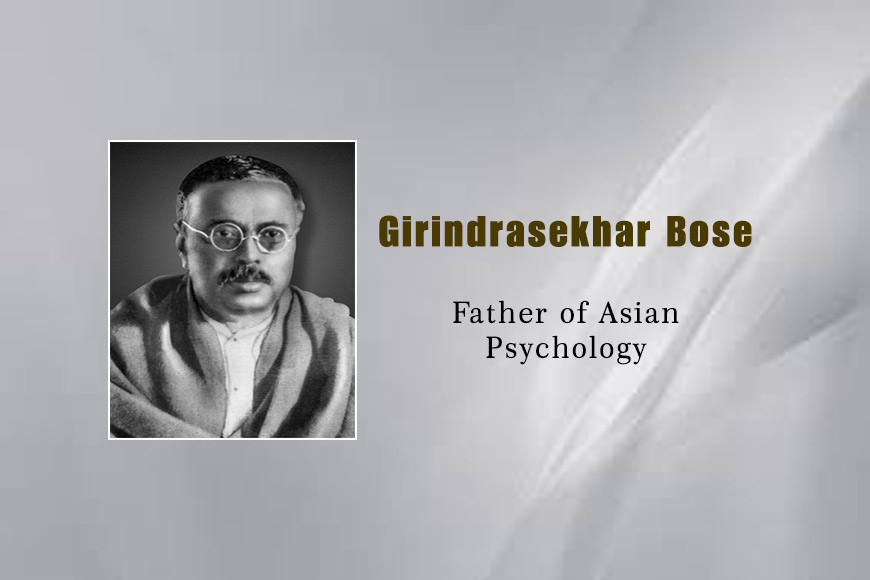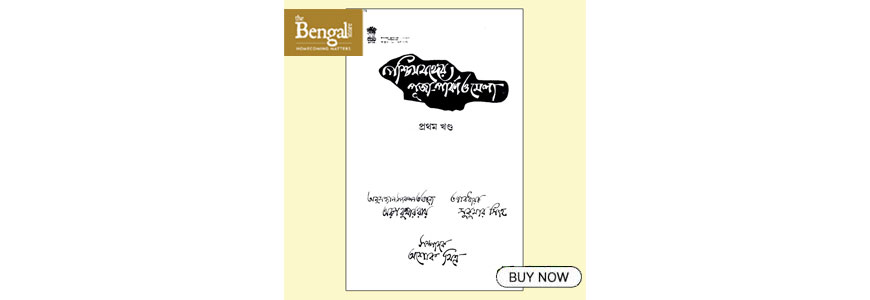Have we forgotten the legacy of Girindrasekhar Bose?

On April 8, 2022, the Department of Post held a special cover release programme at 14, Parsi Bagan Lane, Kolkata, 700009, headquarters of Indian Psychoanalytical Society. Released by the chief guest, Neeraj Kumar, Post-Master General, Kolkata Region, the programme was attended by a number of dignitaries including, Dr Sudhir Kakkar, eminent psychoanalyst and litterateur who was guest of honour and the main speaker and Dr A Bramha, director of Girindrasekhar Clinic. Not many people are aware of the importance of this heritage institution and the man behind this mammoth project.
Tucked snugly in an old alley lies a sturdy, spartan two- storeyed antique house with an ancient mango tree creating a canopy over the building at 14, Parsi Bagan Lane near Rajabazar Science College, the headquarters of Indian Psychoanalytical Society. Established in 1970, the society has been running a psychiatric clinic since then with the help of expert psychiatrists, psychologists, and psychoanalysts and has been offering mental health services to the poorer section of the society for a nominal charge. But who was Girindrasekhar? Not many people have the answer. Acharya Dr. Girindrasekhar Bose is known as the Father of Asian Psychology, who ushered in psychoanalysis in colonial India and integrated psychoanalysis both in theory building and in the practice of mental health in the country.
Dr. Girindrasekhar Bose (more popularly known as G. Bose) obtained a medical degree from Calcutta University in 1910, a Master’s in psychology from Calcutta University in 1917. In 1921 Dr. Bose was awarded the D.Sc. degree of Calcutta University for his thesis, ‘The Concept of Repression.’
“It is most unfortunate that we have failed to carry over the rich legacy handed over to us by stalwarts like Dr Bose who was an institution himself. I would say the fault lies with our approach to teaching psychology in India. Here we address the subject from the Western perspective. So much emphasis is given to the Western approach that we forget to study and interpret our indigenous psyche, conditioned in a very different manner, from the West. We disregard our own instincts and try to fit in problems in compartments where they are misfits and then grope in the dark trying to find solution,” says Dr Nilanjana Mitra, who has done her PhD in Psychology.
In early years of Psychoanalysis practice in India, the subject was being channelized in certain directions by the discovery of the psyche of a ‘savage’ world. A majority of psychologists were engaged in preparing psychometric scales but Girindrasekhar emerged as the prime critic of the colonial stereotypes formulated by Berkeley-Hill, Daly, and later on C. G. Jung. What made Bose's psychoanalytical interpretations of the Indian mind significantly different from those of his Western counterparts was not just underwritten in his difference with Freud and Jung. He was unique in transforming the introspective project of Indian philosophy into a new prose of subtle psychoanalysis.
Being the first student of psychology in India, he laid the foundation of psychology in India and Asia at large. Over a period of 30 years, he, along with his students sensitized masses to mental health issues and created a ‘psychology movement in India.’
The way psychoanalysis won recognition in this century among the ‘scientific’ community in Europe is very different from what happened in India. Brojendranath Seal, who was George V Professor of Mental and Moral Philosophy, made a syllabus for the new course in Experimental Psychology in 1905, after studying various course designs offered in the universities of Europe and America. The first course on psychology in Calcutta University was introduced in 1915, after the establishment of an experimental psychology laboratory. Dr. Girindrasekhar Bose (more popularly known as G. Bose) obtained a medical degree from Calcutta University in 1910, a Master’s in psychology from Calcutta University in 1917. In 1921 Dr. Bose was awarded the D.Sc. degree of Calcutta University for his thesis, ‘The Concept of Repression.’
In 1921, when only a few had heard of Sigmund Freud or read his works, Girindrasekhar was regularly exchanging ideas, papers, notes, photographs and even the Calcutta University MA/M.Sc question papers with him. When Girindrasekhar sent Freud a copy of his thesis ‘The Concept of Repression’, the ‘Father of modern psychology’ not only congratulated him but wrote a recommendation to future publishers: “It was a great and pleasant surprise that the first book on a psychoanalytic subject which came to us from that part of the world (India) should display so good a knowledge of psychoanalysis, so deep an insight into its difficulties and so much deep-going original thought… Dr Bose is aiming at a philosophical evolution and elaboration of our crude, practical concepts and I can only wish, psychoanalysis should reach up to the level to which he strives to raise it.” Correspondence between Bose and Freud continued till 1937.
Bose emphasized on the role of culture in psychoanalysis such as castration anxiety, which he had encountered in his Indian patients. He did not uncritically accept the universal premises of psychoanalysis, but pointed out some of the cultural variations in psychoanalytic concepts in his lively correspondence with Freud. Bose, accepting the id-ego-superego construct of Freud, gave a different meaning to its functions in his theory, ‘A New Theory of Mental Life’. The traditional Freudian metaphor of the mind as a jungle is replaced with a domain of wish fulfillment which is only related to a primordial feeling of love and pleasure. Bose too, like other post-Freudians, did not accept Freud's 'libido theory' but had a different view on the matter, based mainly on his theory of opposite wishes. He said that the word 'instinct' used by Freud should be kept away from the realm of psychology, because explaining mental activities by biological laws is bound to become faulty in many instances. He established the Indian Psychoanalytical Society on 26th January, 1922 and ran a free outdoor chamber in his home to treat mental patients.
Debojyoti Das, who wrote the first biographical article on Bose in Bengali which was published by Bangiya Sahitya Parisad in 1971, is comprehensive and provides a lot of information on Bose, including lists of his Bengali and English writings. Das lamented that, despite great feats in the colonial period, the post-colonial scholars in psychology have hardly attempted to discuss the writings of Girindrasekhar or expressed concern about preserving his works.
Girindrasekhar was the youngest sibling of renowned Bengali author Rajsekhar Bose who is remembered by his pen name, Parashuram. Girindrasekhar also wrote a children’s tale, Laal Kalo. Girindrasekhar was born on January 30, 1887 in Darbhanga district of Bihar. His father, Chandrasekhar Bose was the Dewan (minister) of the Darbhanga Raj Estate. His mother was a poet. Girindrasekhar was the youngest among four brothers -- Sashisekhar, Rajsekhar, Krishnasekhar, Girindrasekhar and five sisters. His entire academic career was brilliant.
Acharya Dr. Girindrasekhar Bose is known as the Father of Asian Psychology, who ushered in psychoanalysis in colonial India and integrated psychoanalysis both in theory building and in the practice of mental health in the country.
Bose had deep and profound knowledge of Indian Philosophy and applied his knowledge of psychoanalysis to give them a new interpretation. He wrote more than 40 articles and authored about 10 books. Freud and his lifelong friend and colleague, Welsh neurologist and psychoanalyst, Alfred Ernest Jones, FRCP MRCS welcomed Girindrasekhar’s initiative to start the Indian Psychoanalytical Society, affiliating it to the International Psychoanalytical Society. Girindrasekhar was also the associate editor of International Journal of Psychology and the German Zeitschrift fur Psychonalysis.
At a time when Calcutta had no state mental hospital or even a lunatic asylum and the British government only ran a small mental observation ward at Bhawanipore to certify “lunatics” in court, Girindrasekhar began the first ever outdoor mental patients’ clinic at Carmichael Medical College (now RG Kar). He was a humanitarian, a devoted teacher, an efficient editor, and a good administrator. One of his most important contributions is the establishment of Lumbini Park Mental Hospital (1938) – a hospital devoted to the indoor and outdoor treatment of mental patients. Rajsekhar Bose gifted a house for the purpose and also supplied furniture and medicines. Starting from a three-bed hospital it grew into an 80-bed hospital – the largest private mental hospital run by any psychoanalytical society at that time. Girindrasekhar and his followers had a tough time running the association without any financial assistance from the government. They encountered acute crisis of food, medicine and shelter for the hapless patients. In the 1980s it was handed over to the state government because of labour problems.
The Indian Psychoanalytical Society (IPS) is based in Kolkata with chapters in Mumbai and Delhi as well. The society has two wings -- Indian Psychoanalytical Society and Indian Psychoanalytical Institute. The Indian Psychoanalytical Institute offers training in psychoanalysis and it has an elected board, president and secretary. The Indian Psychoanalytical Society is run by a council with annual training courses. The board looks after the training procedure, from selection of candidates to final evaluation and also offers one year counseling course. It also organizes memorial lectures, conferences and seminars periodically. The society also offers six months’ certificate course on basic theory of psychoanalysis in association with the West Bengal State University. The society has a priceless library with more than 2500 books on psychoanalysis. It also publishes a quarterly journal named Samiksha. The Lumbini Park Hospital extended the sphere of work at 14 Parsi Bagan Lane. A boundary wall was erected for a mental outpatients’ clinic (Girindrasekhar Clinic). A child-guidance centre and a training institute for senior research students were also accommodated here.
The double-storeyed house with its pink whitewashed walls flaunting hunting trophies, old paintings and photographs including an autographed portrait of Tagore adorn the walls of this heritage building. Many celebrities have set foot at this heritage site. Nazrul Islam was a regular here for undergoing treatment. Both Subhas Bose and his nephew, Dr Sisir Bose were family friends. Satyajit Ray used to drop in. A large number of distinguished visitors including such legendary names as Carl Gustav Jung, Prof. G. M. Carstairs, Dr. W. H. Kiernan, Prof. Samuel Z. Orgel, Dr. Joseph Sandler, Dr. Samuel Erlich, Dr. Laura Katz and others had set foot in this hallowed institution.
Girindrasekhar set up a training school (Bodhayana) for educating normal and abnormal children following psychoanalytic principles in 1949. He established a residential home (Bodhipith) for mentally retarded children in 1951. He along with his brother, Rajsekhar also established the Utkendra Samity, which was more like an adda club with cultural leanings. Beneath the veneer of a grave exterior, both the brothers possessed a great sense of humour. He was interested in diverse activities including yoga, magic and hypnotism and used hypnotic therapy in his medical practice during his early years. Girindrasekhar was a good sorcerer and often entertained children with his magic shows. He also used his skills to develop rapport with the rural patients who were scared of visiting a mental doctor and get treated for their ailments.
Being the first student of psychology in India, he laid the foundation of psychology in India and Asia at large. Over a period of 30 years, he, along with his students sensitized masses to mental health issues and created a ‘psychology movement in India.’ This noted humanitarian soul breathed his last on June 3, 1953, in Kolkata after putting up a tough and prolonged battle against ailments and physical complications.










